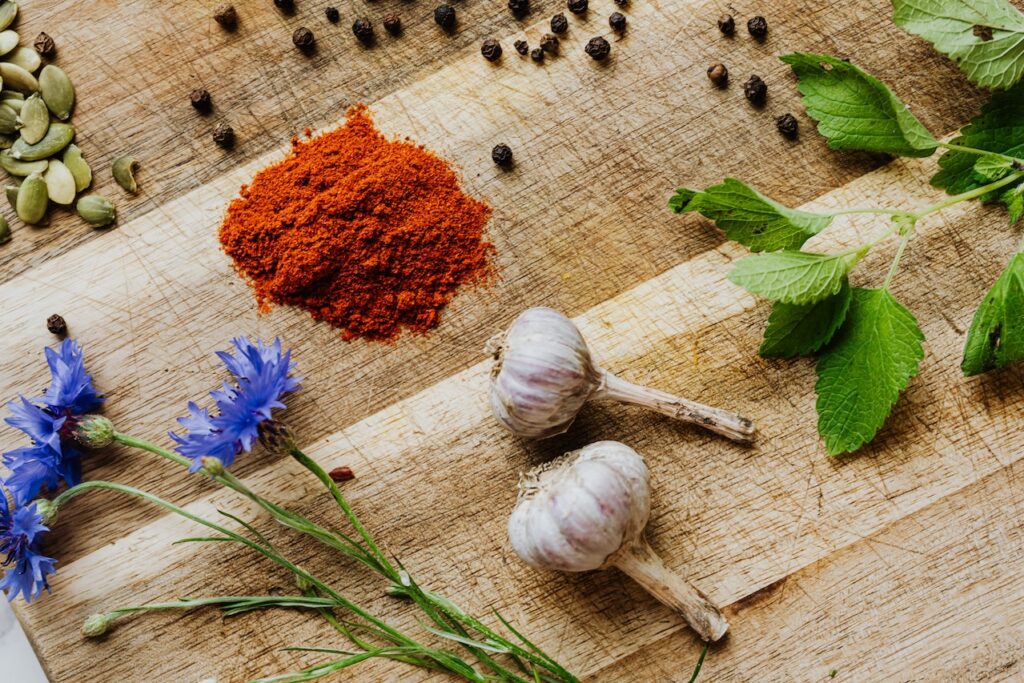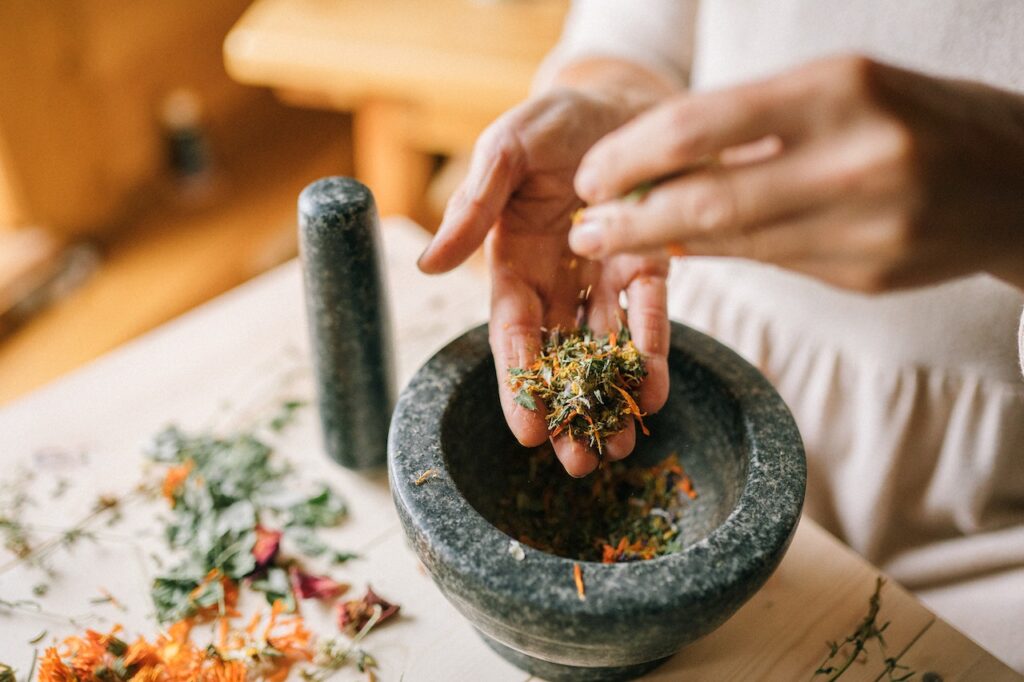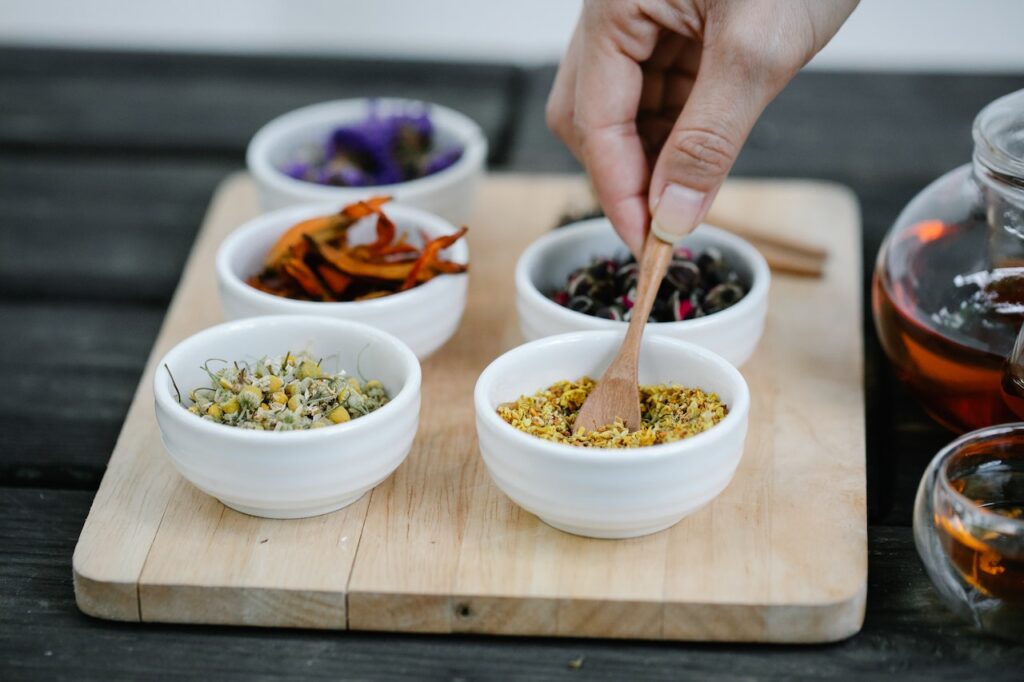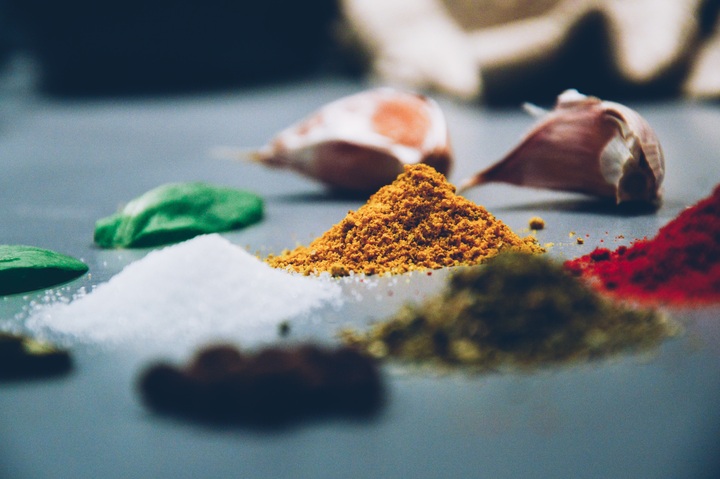Do you want to know the health and flavor of spices and herbs’ benefits? Spices and herbs have been a significant component of human civilization since they enrich our culinary experiences with complexity, taste, and scent. Beyond their function in improving food flavor, spices, and herbs also provide a wide range of health benefits that have been valued and used by several cultures throughout history. These natural miracles, made from plants and their byproducts, have special capabilities that enhance the flavor of our food and our general well-being.
This article explores the world of spices and herbs and examines their culinary and health benefits. We’ll examine the science behind their medical effects, investigate different culinary uses, and learn how to maximize their nutritional value in regular meals. This article will provide helpful insights on harnessing the power of spices and herbs to improve our health and palates, whether you’re a culinary lover, a health-conscious person, or just interested in the wonders of these natural substances. So let’s get started on this delectable adventure and explore the mysteries of herbs and spices together.
The Summary of Spices and Herbs

For millennia, herbs and spices have been used for both culinary and medical reasons. Spices may prevent acute and chronic illnesses and improve the taste, fragrance, and color of food and drinks. More Americans are considering using spices and herbs as medicines and treatments, particularly for various chronic diseases. There is plenty of proof that spices and herbs have cognitive- and mood-affecting characteristics in addition to antioxidant, antitumorigenic, anti-inflammatory, & cholesterol- and glucose-lowering capabilities.
Through its bioactive components, such as alkaloids, phenolic diterpenes, sulfur-containing compounds, tannins, & vitamins, notably flavonoids and polyphenols, research over the last ten years has shown a wide spectrum of health qualities. Spices and herbs including sage, cinnamon, rosemary, clove, & oregano are excellent sources of antioxidants due to their elevated phenolic component content.
It is clear that regularly eating spicy meals was also associated with a decreased risk of mortality from cancer, ischemic heart disease, and respiratory illnesses. The exact function of spices and herbs in preserving health, particularly in preventing the onset of chronic, noncommunicable illnesses, is presently unknown. This analysis emphasizes the possible health benefits of many regularly used herbs and spices, including garlic, rosemary, fenugreek, turmeric, black pepper, chili pepper, and cinnamon.
Benefits of Using Spices and Herbs
Beyond only boosting taste, cooking with spices and herbs has many other benefits. Here are a few of the main benefits:
➤Improved Flavor
Spices and herbs give meals richness, complexity, and depth, making them palatable. They have the power to elevate everyday meals into unique culinary experiences.
➤Reduced Intake of Sugar and Salt
You may reduce the amount of salt and sugar in your food by adding spices and herbs. This is crucial for those who want to reduce their salt or sugar consumption for health reasons.
➤Antioxidant Power
Antioxidants, which aid in defending the body against the harm of free radicals, are abundant in many spices and herbs. For instance, powerful sources of antioxidants include cinnamon, oregano, turmeric, and cloves.
➤Anti-Inflammatory Properties
Many herbs and spices have anti-inflammatory qualities that may help fight bodily inflammation. The anti-inflammatory properties of turmeric, cinnamon, ginger, & garlic are well acknowledged.
➤Digestive Aid
A few herbs and spices help with digestion and ease any pain. For instance, fennel and peppermint may aid with bloating and indigestion, while ginger is often used to reduce nausea.
➤Blood Sugar Control
Cinnamon is one spice that has been shown to help control blood sugar levels & increase insulin sensitivity. People with diabetes or those trying to control their blood sugar levels may find this helpful.
➤Possible Health Advantages
Due to their potential health advantages, many herbs and spices have been utilized in traditional medicine for millennia. For instance, garlic has shown cardiovascular advantages, whereas turmeric has been associated with anti-cancer effects.
➤Diversity and Originality
You may experiment with tastes and add diversity to your meals using spices and herbs. It offers a world of culinary options and may enhance the appeal and enjoyment of your meals.
➤Organic Preservatives
Some herbs and spices have natural preservation qualities that help food last longer by preventing the development of germs and fungus. Oregano, thyme, and cloves are a few examples.
➤Weight Control
Due to their ability to enhance the taste and enjoyment of meals without adding additional calories, spices and herbs might be helpful for weight control. They may increase the attractiveness of healthier foods and lessen the need for dressings or sauces rich in calories.
It’s vital to remember that each spice and herb has a unique advantage and different impacts. The potential advantages may be maximized and added to your diet in various spices and herbs, promoting general health.
The Health Benefits of Using Spices and Herbs in Cooking

The history of herbs and spices is extensive and fascinating. They have been used to preserve Egyptian mummies, as a source of medicine, and to add taste to various meals.
Numerous herbs and spices enhance the taste of food and offer medical benefits. They contain a variety of possible health benefits and are great suppliers of antioxidants. Antioxidants are a fantastic approach to improving general health since they combat free radicals. As a result, everything from weight reduction and heart health to high blood pressure & type 2 diabetes may benefit from the antioxidant characteristics of herbs.
📌Ginger
Southeast Asia is where ginger, a plant whose root is used to make the spice, first appeared. You may use ginger raw, powdered, or juiced for therapeutic purposes. It can also be used as an oil. The most well-known usage of ginger is as an anti-nausea remedy. It may also aid in the relief of nausea brought on by chemotherapy. It can help avoid nausea while you’re ill or pregnant.
Ginger may help control blood sugar. More formal investigations have been done on the relationship between ginger & blood sugar levels. However, this new field of research shows promise.
According to a few animal studies, ginger’s anti-inflammatory antioxidants & chemicals may help prevent the onset of Alzheimer’s disease and safeguard your brain function as you age. Ginger is a common ingredient in many Southeast Asian dishes. This wonderful spice may be used in various beverages, such as teas and juices.
📌Oregano
Oregano is a plant with a wide range of uses indigenous to Europe, the Mediterranean, & Asia. It may be used as a garnish on foods, dried, fresh, or even pressed into herb oil. Antioxidants that help combat free radicals are abundant in oregano. A buildup of free radicals has been linked to the development of chronic illnesses. Oregano oil might have antibacterial & antifungal activities, according to certain studies.
Carvacrol and thymol are the two antioxidants most often present in oregano. Thymol and carvacrol can help to lessen viral symptoms. Additionally, carvacrol has anti-inflammatory effects. The anti-inflammatory effects of oregano may slow the onset of autoimmune diseases, diabetes, and cardiac issues. Oregano is a wonderful addition to sauces, salad dressings, salads, soups, meat seasonings, & stews, in addition to its fantastic health benefits.
📌Cinnamon
This Asian spice is native to Sri Lanka and Myanmar but is grown globally, notably in South America, Vietnam, & the West Indies. It originates from the interior of tree bark. Initially discovered by the Portuguese in the 16th century, it was a precious and uncommon spice. It now comes in stick and powder form and is packed with antioxidants. Furthermore, it possesses anti-inflammatory qualities that might lessen insulin resistance.
Cinnamon contains a lot of polyphenol, an antioxidant. According to studies, cinnamon contains potent anti-inflammatory qualities that may reduce your chance of contracting chronic illnesses. Cinnamon has been demonstrated in studies to improve participants’ insulin sensitivity. Certain diabetic symptoms may be alleviated by cinnamon. Additionally, cinnamon has antimicrobial qualities that may benefit dental health.
You may use cinnamon in savory recipes and sweets as a tasty, sweet spice. You can add some cinnamon to your morning coffee to increase taste and nutrients if you want to include more cinnamon in your diet.
📌Sage
Sage is a mint family member and indigenous to the Mediterranean area. It has a strong taste and is loaded with antioxidants and vitamins. The vitamins A, K, E, & C are plenty in sage. According to studies, sage tea increases antioxidants and decreases harmful cholesterol.
Sage has long been used to enhance dental health since it also contains anti-microbial properties. This research assessed the relationship between sage oil mouthwash & dental plaque and discovered a decrease in streptococcus mutans colony-forming units. Additionally investigated as a diabetic therapy, sage has been shown to improve insulin sensitivity and reduce blood sugar levels.
The culinary herb may be used in teas and extracts in addition to being a great complement to cuisine. Consider including it in soups, roasts, veggies, and herb butter.
📌Black Pepper
Whose cupboard doesn’t have black pepper? Due to its widespread use, salt & pepper crushers on dinner tables all over the globe frequently include it. India is the home of black pepper, which is made from berries. Antioxidants found in black pepper might shield you from the harmful effects of pollution. Piperine is the primary antioxidant found in black pepper.
Blood sugar levels have been reported to rise with black pepper, which may aid in blood sugar regulation. The levels of nutrient absorption may rise due to black pepper. It also has connections to how well nutrients are absorbed.
📌Turmeric
The Southeast Asian spice turmeric, which gives curries their vibrant yellow color, comes from a root. It has a long history of usage in Indian cooking and medicine. The anti-inflammatory and antioxidant-rich substance curcumin is found in turmeric. Its popularity as an anti-inflammatory substance is due to this. According to studies, the turmeric compound curcumin may have antidepressant properties.
Consuming curcumin has been investigated in conjunction with cancer therapies. According to research, It may impact how quickly malignant cells develop. Curcumin may prevent cancer, according to some studies. For its nutritional qualities, turmeric may be utilized as a raw ingredient in food, a powder, and a drink. Although it is tasty and gives your dish a lovely hue, be careful since the color might stain your hands & your kitchen!
📌Rosemary
Another herb from the Mediterranean region, rosemary, is a plant that belongs to the evergreen family. It is a common element in herbal teas and may be added to cuisine in fresh or dried form. Rosemary is rich in several minerals, including manganese, magnesium, and potassium, as well as several vitamins, including vitamin A, vitamin C, & vitamin B6.
Traditional medicine has benefited from the antibacterial and antimicrobial benefits of rosemary leaves. According to studies, rosemary includes acids that may have the ability to inhibit the development of tumors. They may slow leukemia, breast, and prostate cancer tumor growth. Popular spice mixtures, savory recipes, and seasonal cuisines all include rosemary. It may also be added to essential oils and diffused for its lovely aroma.
📌Peppermint
The mint family includes peppermint. It is a product of the cross-breeding of spearmint and watermint plants, and it may have origins in Northern Africa & the Mediterranean. Because of its anti-microbial qualities, peppermint can assist in avoiding bad breath and promote better dental hygiene.
It helps with digestion to consume peppermint. Peppermint has been shown to lessen bloating, indigestion, and gas. It could help lessen nausea sensations. Additionally, peppermint muscle relaxants may help ease stress and discomfort. According to studies, peppermint may be able to reduce migraine symptoms. In addition to being tasty, peppermint has a lovely aroma. It is often used as an essential oil to massage into the skin or add to diffusers, and you can also take it as a fresh herb or in teas.
📌Garlic
Garlic is a recognizable ingredient to most people; it has an intense aroma and is regularly used in food. You may not realize it, but consuming garlic may help keep your heart healthy by preventing certain changes that might cause heart disease.
Some artery hardening with aging is natural. Atherosclerosis is the term for what happens when fatty deposits of cholesterol and other materials accumulate inside your arterial walls. Smoking, high blood pressure, and high cholesterol are among the factors that might make it worse. The arteries get more constricted as the buildup worsens over time. You may become more vulnerable to heart attacks & strokes as a result.
Consuming garlic has been related by researchers to maintaining blood vessel flexibility, particularly in women. Additionally, research indicates that consuming garlic may lower triglycerides and cholesterol. The Mediterranean diet, a healthy eating pattern that cardiac physicians often advise, includes garlic as a crucial component. It may be included in a variety of savory meals.
📌Cayenne
Creole, Mexican, & Cajun food and Southwestern American cuisine all use the chili pepper variety cayenne. Capsaicin is a compound found in cayenne peppers. They are hot because of it, and it also has analgesic properties. Capsaicin lessens the amount of pain messages your brain receives. The outcome? You don’t feel as uncomfortable. It relieves pain brought on by arthritis and nerve damage brought on by diabetes. Creams containing capsaicin may be applied directly to joints and muscles.
According to laboratory and animal studies, eating cayenne pepper may also assist with ulcers, producing many inside discomforts. Despite the common misconception that spicy meals cause stomach discomfort, capsaicin helps prevent ulcers by limiting the development of the bacteria that causes them, lowering excessive stomach acid, and improving blood flow.
📌Cumin
The popular culinary spice cumin is utilized for its fragrant properties. According to the source, it has further advantages for managing stress, cholesterol, and weight reduction. It also has a strong potential for antioxidants.
Cumin is anti-diabetic, according to research. Over 24 weeks, a group of 80 participants who took an Ayurvedic supplement containing cumin substantially decreased postprandial blood sugar.
The Healthiest Spices and Herbs Uses

You’ll still acquire healthy components with fresh and dried spices and herbs. According to experts, frying and grilling might lower the antioxidant content with the spices and herbs, even while simmering, heating in the microwave, or stewing dishes with spices may raise their antioxidant levels.
It’s crucial to remember that commercial supplements must be properly regulated, so you can only be sure what the pills contain if you’re tempted to take supplements to raise your intake of these healthy substances. Testing is done by certain third parties to confirm the quality and content of supplements. Discuss the best form and dosage with your physician or dietician if you’re considering taking a supplement.
Regardless of their other health benefits, spices, and herbs flavor food, may turn healthy meals into pleasant dinners, and are a good approach to breaking eating habits. The secret to sustaining healthy habits over time is to like your meals. Before making any dietary changes, consult your physician or a dietician.
The Amazing Benefits of Spices and Herbs

In addition to enhancing the tastes of our favorite recipes, spices and herbs also provide several remarkable advantages. Here are a few advantages of using spices and herbs.
☑️Brain Protection
Ashwagandha, ginseng, and sage all have neuroprotective and cognitive-improving effects. A 333 mg dosage of sage extract substantially increased secondary memory function and attention in double-blind research with 20 individuals over 65. According to an in-vitro investigation, ashwagandha extract may guard against oxidative harm and toxicity in neuronal and glial cells.
According to a study, ginseng may help memory, learning ability, and motor activity, & protect against Parkinson’s disease and Alzheimer’s disease by promoting neuron survival, supporting neuron development, and combating neurotoxicity.
☑️Prevention of Cancer
Research suggests that several foods, including ginger, red pepper, turmeric, parsley, fenugreek, fennel, rosemary, black cumin, kokum, & Asian ginger, may be cancer-preventive. According to research, a daily ginger supplement reduced the development of tumor tissue and prevented the proliferation of prostate cancer cells by 56%.
Red chilies include capsaicin that may aid in suppressing malignant cells in the tongue, stomach, colon, lung, and prostate. According to research, capsaicin may cause human stomach cells to undergo cell apoptosis, or “cell death,” which is a hopeful development for preventing gastric cancer. A substance in parsley called apigenin can destroy cancer cells while protecting healthy ones.
Research indicated that apigenin significantly slowed the development of skin cancer by 52%. Evidence suggests that curcumin, a substance found in turmeric & curry, may successfully stop the growth of cancer cells.
☑️Prevention of Atherosclerosis
Black pepper, coriander, garlic, and turmeric are heart-healthy and anti-atherosclerotic. A daily intake of 500 milligrams of curcumin (derived from turmeric) was shown to lower lipids, raise HDL “good” cholesterol, and lower total cholesterol in a small trial of 10 healthy individuals. According to studies, black pepper may lower overall triglycerides, phospholipids, fatty acids, and cholesterol levels.
The use of half to one garlic clove daily by persons with high cholesterol has been shown to reduce their total cholesterol levels by 9%. While coriander leaves might guard your arteries against clots, coriander seeds also decrease cholesterol and triglycerides.
☑️Anti-Inflammatory
Evidence demonstrates that lemongrass, rosemary, and thyme may inhibit inflammatory enzymes, whereas thyme, sage, clove, cinnamon, & nutmeg can promote anti-inflammatory enzymes.
One research showed that sage, rosemary, and thyme were anti-inflammatory when consumed raw, cooked, or digested. According to separate research, Thyme & oregano essential oils may both aid in reducing inflammation associated with colitis. These anti-inflammatory properties may shield you against chronic inflammatory conditions, including sinusitis, hepatitis, asthma, and colitis. This is a compelling argument for including more herbs in your diet.
☑️DNA Repair and Protection
Your DNA can be preserved by paprika, ginger, rosemary, sage, heat-treated turmeric, & cumin. After only eight days of ingestion, paprika may stop DNA breaks from occurring, while turmeric can repair DNA breaks that have already occurred, according to research. It’s crucial to note that turmeric that has been heated tends to be the most protective, so if you want to benefit, be sure you take it with cooked foods.
Spices and Herbs Other Beneficial Purposes
Herbs and spices are used for a variety of different things outside only cooking. Here are a few instances:
👉Medicinal Uses
Traditional medicine uses a variety of spices and herbs because they have therapeutic qualities. For instance, ginger is used for digestive disorders, turmeric is recognized for its anti-inflammatory effects, and garlic is thought to have antibacterial characteristics.
👉Aromatherapy
Aromatherapy makes use of essential oils that are derived from plants and spices. These oils are said to offer healing properties for the body and mind. For instance, eucalyptus oil treats respiratory issues, lavender oil promotes relaxation, and peppermint oil promotes mental clarity.
👉Air Fresheners
To make potpourri or homemade air fresheners, dried herbs and spices like lavender, cinnamon sticks, rosemary, & cloves may be utilized. They enhance the smells in the space and may also keep insects away.
👉Organic Cleaning Products
You may use certain herbs and spices as natural cleaners. For instance, baking soda mixed with essential oils may make a DIY cleaning scrub; white vinegar and lemon juice can eliminate stains and smells.
👉Insect repellents
Eucalyptus, Citronella, and lemongrass are a few plants and spices that naturally ward off insects. They may be cultivated in gardens to deter insects or utilized in candles, sprays, and other products.
👉Cosmetics and Skincare
Due to their beneficial qualities, spices, and herbs are often utilized in cosmetics and skincare products. For instance, rosemary and tea tree oil are included in hair care products because they can soothe the scalp and cure dandruff. At the same time, turmeric is used in face masks for its brightening & anti-inflammatory qualities.
Frequently Asked Questions
What use do spices serve?
Spices are used to taste, color, preserve food, and improve palatability. Spices are used in various industries outside of cooking, including the pharmaceutical, cosmetic, and fragrance industries.
How do herbs affect the body?
Said herbs break up toxins, clean, lubricate, strengthen, and feed the body to enable it to perform its job. They help the body at its most fundamental levels, aiding nature in its battle against disease and enhancing health.
What is the best method to consume herbs?
In 1/4 – 1/2 cups of water, ingest herbs. The formulations should be consumed on an empty stomach for a quicker impact. Doses should be taken with food or after meals for those with more sensitive digestive systems.
Why are herbs and spices different from one another?
A plant may produce spices from various sections, including nuts, bark, roots, & seeds. On the other hand, herbs originate higher up; that is, they are often the plant’s leaves & stems.
Do spices provide health benefits?
More than 100 popular spices are used in cuisine across the globe, and several are rich sources of antioxidants, which are chemicals that protect your cells from oxidative harm.
Final Words
The benefits of spices and herbs extend far beyond their ability to enhance the flavor of our favored dishes. Spices and herbs add flavor to food but are also nutrient-dense powerhouses that provide numerous health benefits. People who include spices and herbs in their diets may experience some health benefits or enhancements, but they should not rely on them as a sole treatment for their conditions. So, whether it’s a sprinkling of turmeric, a dash of cinnamon, or a fistful of fresh basil, incorporating spices and herbs into our daily lives can greatly improve our culinary experiences and overall health. Do you want to know the herbs for UTI treatment? Click Here!

